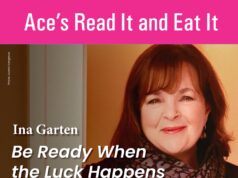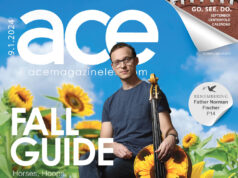Entering our tenth year and feeling a bit nostalgic we felt it might be nice to share a bit of Latitude’s past with Ace readers using a few of the many past articles from Ace as our time capsule.
Ten years ago Ace Weekly published its first article on Latitude. In it Crystal and I articulate our vision of the program we were right in the midst of creating. At the time we were weighing the notion of creating a kind of policy institute rather than a more traditional site based program. In the end we opted for a combination of both.
A Little ‘Latitude’ New program meets unique artistic needs
By Mark Heidinger
Lexington artist/activist Bruce Burris and recreational therapist Crystal Bader began the groundwork for Latitude. In its current form, Latitude exists as a think tank aimed at collaborating with various programs in the Central Kentucky area to provide outlets for expression for individuals considered by some to have a disability. In its fully realized form, Latitude will serve as a voice ….influencing local, regional, and national communities with an emphasis on empowering and listening to each individual’s story.
Latitude remains “little” as we recognize that really knowing and understanding the artists in our program is the key to their success- and to ours.
Through the years our mission has been to illuminate the lives of those considered by some to have disabilities this has been aided by chronicling their achievements through the publication of many articles and features.
In an Ace article from 1994 Sarah Tackett described the feel of Latitude.
A Lotta Latitude Art with perspective By Sarah Tackett
Latitude, like any studio downtown, is busy with artists working towards upcoming projects. They are currently presenting a studio showcase at ArtsPlace, that opened last week.
……It’s a matter of perspective, a key word that Latitude incorporates in their title, Latitude: movement/perspective/autonomy. Great words, right? Thinking words. Inspiring words. Words that seem more associated with French philosophers than habilitation programs containing disabled people.
Unfortunately, “contain” is what most of these programs do. Latitude is usually seen as an anomaly, a feel-good irregularity, rather than the rule. Burris explains, “Most of the articles written about us are fluff pieces, but there is a critical element to our work as well that needs to be addressed.” He speaks of a university professor who admits that 99 percent of the community habilitation centers he studies are not places where anyone would want to spend the day…. Burris adds, “My point is that 9 out of 10 of these places are really not fit for human beings.”
Latitude is different. It’s an attractive, welcoming environment. Located downtown, the studio has high ceilings, and the walls are covered in vibrant artwork. People work intensely and independently between conversations, while the Rolling Stones blare in the background. It is a pleasant place to work for anyone… It’s the whole Kennedy and country thing that got lost somewhere in the 80s—to find itself popping up in the middle of Lexington over 40 years later. Wow is right…..
Latitude has two major components, a community arts studio/exhibition component and an advocacy component dubbed Project Easy Access Lexington or PEAL.
This article which appeared in 2006 summarized the beginnings of PEAL.
Accessibility Awareness Day could be celebrated everyday
By Bruce Burris
The wheelchair plunges into a hole created by a displaced paving brick, and due to its momentum jackknifes left; my hands are wrenched from the chair handles, and Belinda is almost thrown from her chair onto the wet pavement. This is this not an unusual event; it is a very normal part of walking in downtown Lexington for many of us considered to have a disability.
After catching our breath and checking for damage, we look at each other, and in Belinda’s gaze I noticed something other than resignation…. Belinda Sellers has amazing perseverance, and as we talked about our experience, Belinda asked what we might be able to do about this problem, and Project Easy Access was begun….
Since the publication of that article Project Easy Access Lexington (PEAL) program has:
• founded LFUCG’s Commission for Citizens with Disabilities
• has organized 3 public rallies which raised the issues of accessibility and transportation
• was the first area disabilities advocacy organization to sponsor a public rally related to regional disability issues
• taken more than 700 people on our “Downtown Inaccessibility Tour”
• advocated successfully for an appropriate Wheelchair lift in Lexington’s City Hall
• has been periodically repairing downtown sidewalks on our own since 2007
• `and much more
As a multi disciplinary arts program the successes of Latitude artists are well known. From Jessie Dunahoo’s incredible sewn plastic bag installations to Beverly Baker’s knowingly dense drawings, in the past few years Latitude artists have received important Fellowships, exhibited their artwork from New York to Paris and have been featured on national television shows. In 2008, Lexington artist Louis Zoellar Bickett summarized our program in an article for Ace written by Crystal.
“When I think of ‘Community Outreach’ I think of Latitude. It is the perfect amalgam of philosophy and action. The work of Latitude (as an organization), is in my view, one of the most important ‘art works’ being produced in the country, giving hope and meaning to those in society that have the least voice. The icing on the cake is that the work produced by these artists is nothing short of amazing…….. In short Latitude is a National Treasure.”
This seems like a great way for us to leave things for now and after ten years you know we’ll keep you updated! Crystal and I want to thank you for your support over this time.




